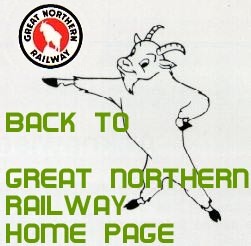|


| |
GN Electric Operations continued
to increase above running amperes. The helper engineer
will then notch off to reduce his amperes to normal, and in
this way follow the train engineer on down to a stop, at
which time helper engine will be almost shut off and D. C.
amperes on his cabs showing 200 to 400, if General
Electric, or 1500 to 2000 if Westinghouse. When train is
stopped, helper can shut full off and train engineer, before
shutting full off after stop or stall is made, should set engine
brake to keep from rolling back.
(2) If something is wrong where helper engine wants
to stall train, the same method will be used. Helper will
gradually ease off and head end must follow. Failure to
carefully observe load changes in meters during such stops
will result in break in two and trouble for those
concerned.
Starting After a Stop on Grade
Notch out on controller before releasing brake so train
will not roll back and break in two. For quick stops, or
other emergency, naturally use the air.
Special Instructions: Power Stalling a Train on an
Ascending Grade When Line Power Lost, or
When Cabs Kick Out
Loss of power on any electric unit in a train requires
that controllers be shut full off in order to reset the circuit
breakers.
Loss of power occurs in several ways:
(1) Power loss on trolley, in which case a simultaneous
loss of power on all cabs takes place. There is only one
thing to do in such cases and that is stop.
Special: When trolley power is lost, and engineer is slow
on setting air, usually the rear end slack runs in, then
runs back and breaks off a drawbar or knuckle. This has
been prevented effectively by engineers dynamiting the
air just as train stops. The road engine, helper engine or
conductors valve are equally effective in preventing such
type of break in two.
(2) Power loss on any one unit: With Westinghouse
cabs, quickly move meter changeover switch to a live cab
if kickout occurs on the operating cab, then gradually
ease off to zero load and reset. Ordinarily the helper can
keep train moving until you pick up the load again, or he
will stall when its evident you cannot reset immediately.
If General Electric cabs kick out (a) any trailing cab
kickout will simply increase the load on other cabs and
Page 45
you will make an ordinary stall stop at full amperes D. C.
on remaining cabs and reset when controller is full off.
If helper keeps you going, then very carefully pick up to
full D. C. amperes, as trains are easily torn apart by too
quick notching (changing slack), (b) If operating cab
kicks out, do not immediately shut off or the slack piling
in may do damage. Drop three or four notches and then
gradually drop load on other cabs until that slack gets
gradually' bunched, then shut off and reset. Never be
abrupt in either dropping or picking up load, as it is the
too sudden variations in slack that causes trouble, whether
train is being pulled, pushed or regenerated.
Loss of power or kickouts on locomotives occur from
causes outside of locomotive, as:
(1) Trolley system kickouts.
(2) Locomotive disturbances, (a) In the D. C. circuit
as traction motor overloads trip due to slipping, etc. These
do not bother M-G set. (b) A. C. circuit troubles or
overloads which trip out A. C. overload relays, shutting down
M-G sets. That is why a report reading "cabs kicked out"
does not mean anything, as it should be specified what
kicked out, as on General Electric trolley relay, ground
relay or overspeed relay by kicking out will shut down
M-G set, necessitating a closing of the relays and re-starting
M-G set, while a kickout of JR or D. C. circuit breakers
merely requires that they be reset and engine will pull
okay, the M-G set not having been affected.
On Westinghouse cabs, a kickout of A. C. overload, oil
circuit breaker or overspeed will shut down M-G set, while
a traction overload merely cuts out power to traction motors,
and engine works okay when reset is made.
Kickouts on Locomotives Regenerating
Trains in regeneration are running with slack bunched,
and under all conditions it is up to engineers, both train
and helper, to keep slack bunched at all times.
Power Kickout on Trolley
Road engineer quickly open sanders and set engine brake
up to 25 or 30 lbs., brake cylinder, to keep engine back
against train, while he sets automatic air to stop train,
keeping engine brake bled to 25 or 30 lbs., so drivers will
not skid while stopping.
Page 46
Road Engine — Any Cab Kicks Out
Either stop completely, or (1) open sanders, set only
engine brake 25 to 30 lbs., brake cylinder, keep slack
bunched. (2) Shut off both field and speed levers. (3) Reset
overloads, and put engine into normal regeneration, then
release engine brake. All the while, slack has been kept
bunched, and except for care in keeping drivers from
skidding or tires getting loose from heat, entire operation
completed in one to two minutes.
Helper kickout: Shut off and reset, then pick up load.
Trouble Shooting and Sequence on General Electric and
Westinghouse Locomotives
Trouble on electric locomotives of the M-G type - can
occur in any of the following places:
(A) Control circuit trouble, as:
(1) Oxidized and corroded relay, interlock or connection contacts.
(2) Improperly set or functioning of relays due to open circuits
where they fail to operate, or short circuited coils and
resister tubes which cause relays to operate at wrong time.
(3) Broken, corroded or short circuited control interlocks.
(4) Blown control fuses or defective mechanical condition
of controllers, push buttons, etc.
(B) Main power circuit troubles, as:
(1) The simpler variety of stuck or welded in switches.
(2) Oxidized contacts.
(3) Loose or broken flexible switch shunts and contacts.
(4) Mechanically stuck magnet valve armatures
which get corroded so they do not move freely, and can
fail in two ways, one by sticking so that when coil is
energized the switch cannot close, another where they stick so
that when coil is de-energized, switch will not open. Either
case might be mistaken for electrical control trouble if, not
carefully checked up.
(C) The main power circuits are of two kinds, the A. C.,
comprising the transformer and synchronous motor, and
the D. C., which takes in the main generators and traction
motors. Transformer primary voltage is the 11,000 volt
trolley, while the synchronous motor voltage is 1,250 A. C.
on Westinghouse and 2,500 A. C. on General Electrics.
Unnecessary to go into details on this, for if anything breaks
down to ground or short circuits, you will not be in doubt
as to where it is — the fireworks will be its location. When
trouble occurs on these circuits, the locomotive is through.
Lower pantographs close ground switches and put out any
Page 47
fire that may be started. Never apply power after a
machine breaks down to ground or shorts, as you will wreck
it completely. The D. C. circuits on General Electrics are
750 volts, and 600 volts on Westinghouse. D. C. machines
are subject to flashovers, shorts, grounds, and open
circuits. When generators are badly damaged by any of
these, cabs are out of service. Individual motors or groups
may be cut out, and cab used on .reduced tonnage if
necessary.
Power circuit troubles are not necessarily in the
machines themselves. Cables, switches, insulators or any
connected apparatus failing, will put the whole circuit out of
service. Summarizing power circuit trouble:
(1) Shorts in transformer or synchronous motor circuit,
puts cab out of service always.
(2) Flashovers, shorts or grounds in traction motors do
not necessarily put a cab out of service, as motors
individually can be cut out in Westinghouse cabs, and they are
cut out in groups of two motors in General Electric cabs.
(3) Generator shorts and grounds usually put machine
out of service at first shot, while generator flashovers, if
not too severe (so that roughened commutator surface
chews up the brushes) or failed brush arm insulators are
so badly shot as to ground both positive and negative sides,
by running locomotive at a lower voltage notch or speed,
you can usually get into a terminal. In all cases of severe
trouble or fireworks on any circuit, call electric shop for
instructions to minimize damage.
(D) Troubles may occur as a result of sudden breakdown
on any circuit whether it be control, auxiliary power
or main power circuit, electrical, pneumatic or mechanical.
Locomotive trouble may also be induced as a result of
improper handling of the motoring, regeneration or air brake
controllers by engineman. Such come under the heading
of "man failure." This in majority of cases can be
prevented by proper training of men in the technique of
handling the electric motive power. However, unless the
individual men apply themselves to acquire this technique, and
have good judgment along with necessary experience in the
handling of trains, regardless of type of motive power,
training alone will not do. Any man who is a good
engineer on steam, need have no fear of electric or any other
motive power, for all you have to do is run them per
instructions.
Page 48
 
 
|